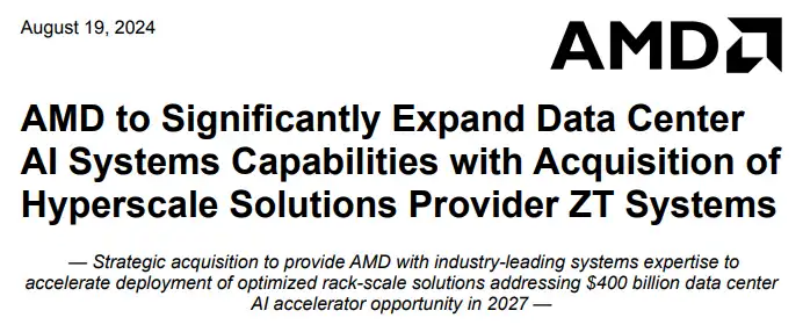On Monday, U.S. chip giant $Advanced Micro Devices(AMD)$ announced on its website that it has signed a final agreement to acquire ZT Systems for $4.9 billion.
AMD will pay this $4.9 billion in a mix of cash and stock. According to media reports, 75% of the payment will be in cash, with the remaining 25% in stock.
ZT Systems, founded in 1994, is a provider of AI and general-purpose computing infrastructure. Their products include high-performance computing (HPC) servers and storage servers, mainly serving large cloud companies and enterprise clients with customized solutions.
A report from JPMorgan on Tuesday noted that ZT’s strong design and service capabilities could boost AMD’s deployment of AI servers in data centers. $NVIDIA Corp(NVDA)$ might push hyperscale computing firms to outsource their AI servers to other ODMs besides ZT, potentially intensifying market competition.
AMD CEO Lisa Su stated in a press release:
“Acquiring ZT Systems is a key next step in our long-term AI strategy.” She added, “ZT brings world-class system design and rack-level solution expertise, which will significantly enhance our data center AI systems and customer support capabilities.”
Su also mentioned that AI systems are AMD’s top strategic priority. She told the media that with ZT Systems' engineers joining AMD, the company will be able to test and roll out new AI GPUs faster to meet the demands of cloud giants like $Microsoft(MSFT)$ .
“The main benefit is that we can sell more GPUs,” Su said. She also noted that AMD has no intention of competing with companies like $SUPER MICRO COMPUTER INC(SMCI)$ . After the deal is finalized, AMD plans to spin off and sell ZT’s manufacturing assets while retaining its system design capabilities.
For investors who are bullish on AMD in the long run, a diagonal spread strategy could be worth considering. Compared to a standard bull spread, a diagonal bull spread offers a lower cost of investment and is a solid long-term bullish strategy.
What is a Diagonal Spread?
A diagonal spread is an options strategy involving options with different strike prices and expiration dates. Typically, the long leg of the spread has a longer duration than the short leg. Diagonal spreads include diagonal bull spreads and diagonal bear spreads.
A diagonal bull spread is similar to a standard bull call spread but with an upgrade. The difference is that the two options in a diagonal spread have different expiration dates. In this strategy, you buy a long-term call option with a lower strike price and sell a short-term call option with a higher strike price. The number of bought and sold call options remains the same.
Example with AMD
Suppose you are bullish on AMD for the next month. You could buy a call option expiring on January 17, 2025, as your long leg. This would cost $1,815 based on the latest price.
Once the long leg is established, you set up the short leg with a shorter-term call option. For instance, you could sell a call option with a $165 strike price expiring on August 23, earning a premium of $51.
If the sold call option expires worthless, you make a profit of $51 on top of the $1,815 spent on the long leg, which is about 2.8%. Since the short leg can be sold weekly, with the long leg lasting for 151 more days, you could sell the call option 10 times. If all 10 sales generate premiums, they will significantly reduce the cost of the long call option.
A diagonal spread, compared to buying a call option outright, provides an extra premium income, lowering the net cost of the strategy and shifting the breakeven point to the left, increasing the probability of profit.
Additionally, you can control the selling points in a diagonal spread, allowing you to adjust the short leg based on different time frames, which helps manage risk. Essentially, a diagonal spread is a low-cost way to buy call options, making it a strategy worth considering.

Comments